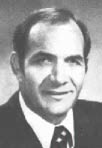In Search of Lost Arch Space
The article by Dr. Ten Hoeve in this issue points to one of the important details in occlusion that is frequently overlooked in orthodontic diagnosis and treatment--molar rotation.
Mesiolingually rotated molars are in malocclusion and contribute to the malocclusion of teeth mesial to them. Since they are the first of the permanent posterior teeth, they can erupt in a rotated position and drift forward in a rotated position, increasing the arch space they occupy and decreasing the arch space mesial to them. They are frequently misdiagnosed as being in a Class II relationship, because the mesiobuccal cusp of the upper molar is rotated mesiolingually. Dr. Ten Hoeve quite correctly points to the importance of the position of the mesiolingual cusp of the upper first molar in diagnosing the molar relationship.
Mesiolingual molar rotation as a result of treatment occurs in both arches. It may be one of the most frequent deficiencies in "finished" cases. The chief culprits in the creation of this rotation appear to be intra-arch elastics on both arches, Class II elastics on the lower arch, and Class III elastics on the upper arch--especially when light round archwires are used. Attempting too much gathering with a positioner appliance can also produce these rotations. This was more of a problem when bands were used exclusively for attachment of brackets. Left uncorrected, pretreatment and treatment-induced rotations prevent the achievement of an optimum orthodontic result, and they contribute to poor occlusion and to potential periodontal problems.
Haste in getting the arches banded/bonded may contribute to overlooking molar rotations, and there may be some thought that they automatically correct on a full arch. They might, but the jamming mechanics involved slows treatment and places unnecessary stresses on other teeth.
Molars, upper first and second bicuspids, and lower second bicuspids are narrower mesiodistally than they are when rotated any amount. Upper and lower cuspids are wider mesiodistally than when rotated any amount short of 90°. Lower first bicuspids are virtually round. The teeth other than the incisors whose rotation without tipping increases arch length most are upper and lower molars and lower second bicuspids and cuspids.
Dr. Ten Hoeve refers to the "hidden space" in the mandibular arch that is occupied by the wider dimension of rotated posterior teeth and made available by their derotation. It is available if care is taken, as hp points out, to control the space that is gained in this way. There is a hidden loss of arch length in a deep curve of Spee. Baldridge1 showed that mandibular dental arch length increases in direct proportion to the amount the curve of Spee is leveled, and he developed two formulas for accurately predicting the amount the dental arch is lengthened when the curve of Spee is leveled. This is another factor that is rarely taken into consideration in diagnosis. In his classic article, "The six keys to normal occlusion",2 Andrews pointed to the confinement of the upper teeth by a deep curve of Spee and the possibility that only the upper first bicuspid can be in normal occlusion.
Another often overlooked occlusal factor is the axial inclination of teeth. Teeth occupy increasing amounts of mesiodistal space as their axial inclination increases. Thus, mesial inclination of upper molars is often combined with mesiolingual rotation, and the increase in arch length is greater than is produced by rotation alone. Distal movement to upright a mesially inclined molar, plus derotation of a mesiolingual rotation, can create a great deal of arch length. Uprighting molars on a full arch is not automatic, unless special mechanics are provided for it, and not easy in any event. With preangulated brackets, there may be more built-in attention to the axial inclinations of the bicuspids, cuspids, and incisors, but these cannot be ignored in treatment and presumed to be automatically taken care of. In the "six keys" article, Andrews refined the axial inclination of teeth to axial inclination of the crowns.
Another feature must be arch form, and cross-arch width in the cuspid, bicuspid, and molar regions. Together with proper buccolingual and labiolingual torque, these are also importantly related to arch length and to correct and stable occlusion. The development of an ideal occlusion still seems to be a product of the fulfillment of Andrews' six keys, with a few additional considerations.


